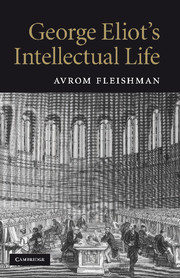Book contents
- Frontmatter
- Contents
- Acknowledgements
- Preface
- Introduction
- 1 The “Evangelical”: starting out in a Christian culture
- 2 The Apostate: moving beyond the Christian mythos
- 3 The Journalist: editing, reviewing, shaping a worldview
- 4 The Germanist: balancing the counterweight of German thinkers
- 5 The Novelist: mixing realism, naturalism and mythmaking
- 6 The Historian: tracking ideals – utopian and national – in Romola and The Spanish Gypsy
- 7 The “Radical”: taking an anti-political stance in Felix Holt
- 8 The Encyclopedist: transcending the past in Middlemarch
- 9 The Visionary: transmitting ideals in Daniel Deronda
- 10 The Intellectual: cultural critique in Impressions of Theophrastus Such
- Notes
- Works cited
- Name index
2 - The Apostate: moving beyond the Christian mythos
Published online by Cambridge University Press: 05 April 2010
- Frontmatter
- Contents
- Acknowledgements
- Preface
- Introduction
- 1 The “Evangelical”: starting out in a Christian culture
- 2 The Apostate: moving beyond the Christian mythos
- 3 The Journalist: editing, reviewing, shaping a worldview
- 4 The Germanist: balancing the counterweight of German thinkers
- 5 The Novelist: mixing realism, naturalism and mythmaking
- 6 The Historian: tracking ideals – utopian and national – in Romola and The Spanish Gypsy
- 7 The “Radical”: taking an anti-political stance in Felix Holt
- 8 The Encyclopedist: transcending the past in Middlemarch
- 9 The Visionary: transmitting ideals in Daniel Deronda
- 10 The Intellectual: cultural critique in Impressions of Theophrastus Such
- Notes
- Works cited
- Name index
Summary
George Eliot's demystification was astonishingly abrupt, and the abruptness calls for an attempt at explanation almost as much as the demystification itself. Perhaps the most remarkable aspect of the process was its serenity; though not particularly Evangelical, as we have seen, she was a normal churchgoing Anglican of the time, few of whom, so far as we know, lost their faith as decisively as she. The peculiarity of her change of mind conforms to a rubric later put forward by John Henry Newman, the distinction between certainty, the coming to a logical conclusion, and certitude, the total conviction of religious faith. Eliot's change was, I shall try to show, of the former variety.
It is worth going over the precise dating of the events in her intellectual and social life. On March 17, 1841, Eliot moves to Coventry to enjoy its social life in view of greater marriageability; almost five months later, on August 12, she declares, “I am alone in the world” (Letters I, 102); on November 2, she anticipates a visit to the family of Charles Bray, “I am going I hope to-day to effect a breach in the thick wall of indifference behind which the denizens of Coventry seem inclined to entrench themselves, but I fear I shall fail” (Letters I, 120). In her next letter to Maria Lewis, she writes, “My whole soul has been engrossed in the most interesting of all enquiries for the last few days, and to what result my thoughts may lead I know not – possibly to one that will startle you, but my only desire is to know the truth, my only fear to cling to error” (Letters I, 120–21; Nov. 13, 1841).
- Type
- Chapter
- Information
- George Eliot's Intellectual Life , pp. 24 - 43Publisher: Cambridge University PressPrint publication year: 2010



